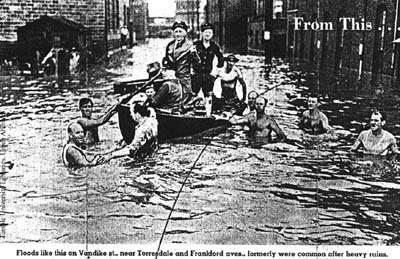
A flood in Frankford (year not noted) from a March 18, 1956 Sunday Inquirer story
celebrating the diversion of Frankford Creek into a new channel.
Part 2
Sewers and Sewage Treatment
|
DOWNLOAD TIMES
|
Frankford Creek
Navigation, Dredging, Channel Changes and Jurisdiction
1799-1956

Sewers and Sewage Treatment
Pollution, Plans and Delays

Rock Run Sewer under construction in 1922. Formerly a tributary to
Tacony Creek, Rock Run now appears only on the City's sewer plats.

|
Sewer History Home Page |